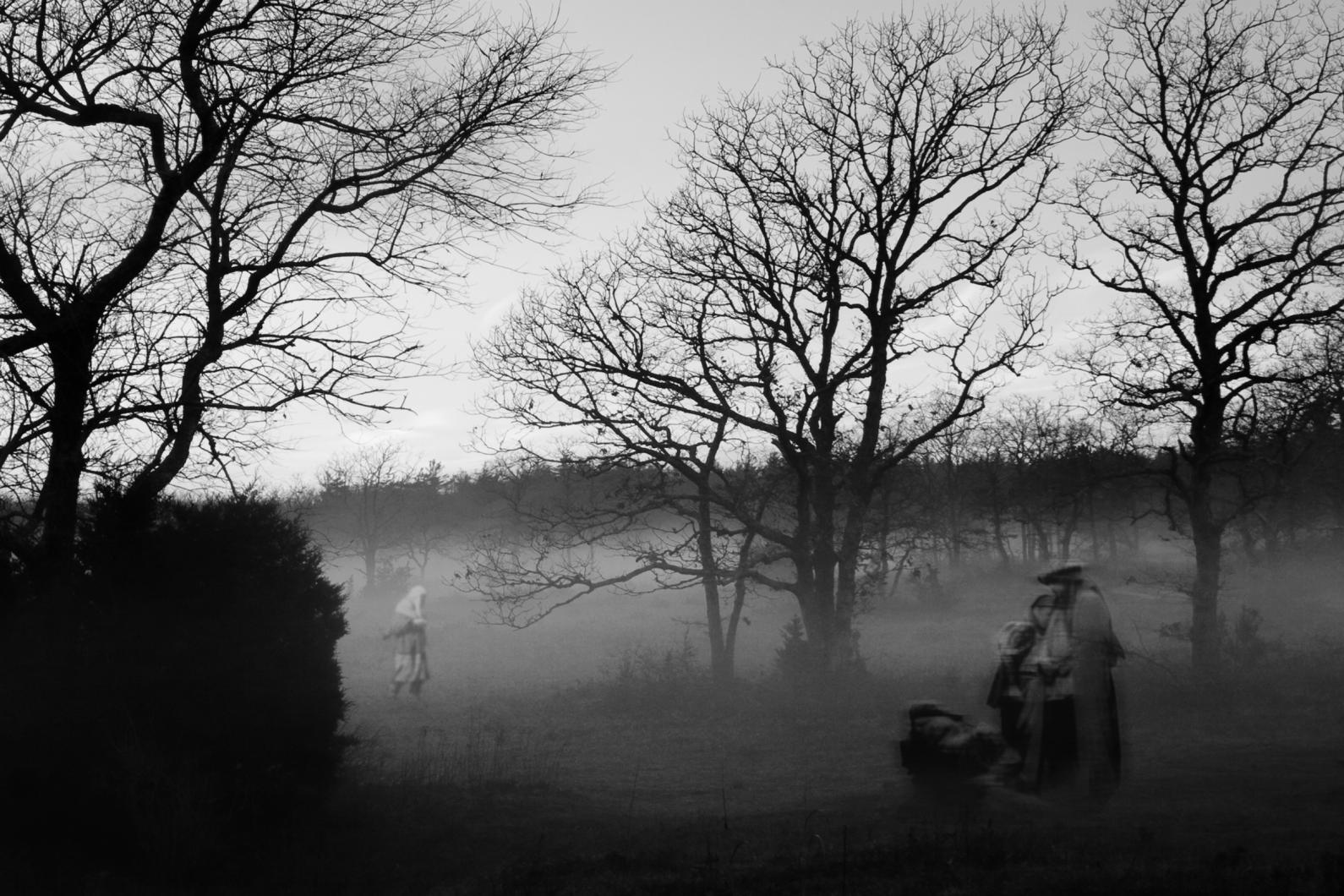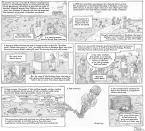Editor’s Note: What follows is an excerpt from Holly Mascot Nadler’s latest book, Vineyard Supernatural, True Ghost Stories from America’s Most Haunted Island. Because the Vineyard and its smaller Island neighbors are rich in both history and hauntings, the spirit of Halloween is unusually potent here. So while out celebrating with friends and family this night, it might be a good idea to remember what they say on Penikese: “You gotta respect the ghosts.”
. . . We might as well turn to Wampanoag legend to find out how Penikese and its sibling islands off the northwest coast of Martha’s Vineyard were created:
One day the Indians on Cape Cod called on their giant protector, Moshup, to help them out. They were being assaulted by Pukwudgees, little ten-inch tall demons who made the Indians’ lives miserable by breaking their arrows, jabbing holes in their canoes, and scattering sharp objects on the hunting paths. Moshup gathered up a posse of his five sons and tracked the mean little critters through the wetlands. But the malicious and clever ‘wudgees crept up on the avengers, blinding and then killing the five young giants. Devastated, Moshup carried his dead boys to Buzzard’s Bay, built up mounds of rocks and soil over them, and slunk away, his years of playing the Lone Ranger to humans abruptly ended. Meanwhile the ocean rose, carrying the burial mounds way offshore, where they became what are now known as the Elizabeth Islands — Naushon, Pasque, Nashawena, Cuttyhunk and Penikese.
As early as 1003, Vikings may or may not have landed on Penikese. In 1524, explorer Giovanni da Verazzano may have rowed ashore there; ditto French navigator Jehan Alfonce in 1542, according to one published history of the Vineyard. Definitely, English explorer Bartholomew Gosnold and a few of his crew checked out the island in 1602, but he got Penikese history off to a bad start when he frightened off four visiting natives and swiped their canoe, leaving them stranded.
Clearly no one took the tiny, ladybug-shaped island seriously until 1873, when the Anderson School of Natural History was established there. This noble institution’s sprawling and grand Victorian buildings — a laboratory, a dorm, a dining hall and the Anderson Mansion — resembled a mini-Harvard overlooking the sea from Penikese’s southern bluffs.
Philanthropist John Anderson hired brilliant and internationally known scientist Alexander Agassiz to spearhead the new school. Unfortunately, Agassiz became deathly ill during his first summer on Penikese. He was shipped off-island to recover, but died instead. The school lasted only one more year, and a sense of Penikese being jinxed has prevailed since.
So, where better to establish a leprosarium than on this sad and lonely little rock?
•
Humankind has had a shuddering dread of leprosy for millennia, mainly because the disfiguring illness was incurable and untreatable. Nowadays it’s still incurable, but it can be arrested with medications. It was also presumed to be contagious, but what folks never knew until modern medicine came along was that ninety-five percent of people are naturally immune to it.
And, back in the day, its unfortunate victims looked phantasmagorically scary as their extremities were ravaged with lesions and eroded away by secondary infections.
The only prescribed measure was to banish these victims to remote outposts where they would spend the rest of their days removed forever from family, friends and the world. The poor were shipped off to facilities such as the newly inaugurated Penikese Island Hospital, opened in 1905.
The colony created controversy from start to finish. Newspaper editorials railed against the proposed facility with rants such as this one in a Buzzard’s Bay journal: ‘’A national leper colony on Penikese Island will be a standing invitation for other states to dump their lepers. No laws can keep them out!”
Nonetheless, the plan moved forward. The old Anderson mansion was refurbished for head doctor Louis Edmunds and his staff, and small cottages were constructed to house the afflicted residents. Each building measured 36 feet by 27 feet, with a kitchen, living room, bath, and two single bedrooms. The Massachusetts Board of Charity found five people who were willing to work on the island. At the outset, there were also only five patients.
Circumstances could not have been more miserable for those first inhabitants of the leper colony.
Frank Pina, 38, originally hailed from the Cape Verde islands. After his diagnosis by Dr. Edmonds, Pina was removed to Penikese and his wife and eight children were forced to leave their rented cottage in Harwich and move to the far side of town.
John Roderick, 34, arrived on Penikese, according to Dr. Edmonds, “Very sick, and slowly dying.”
Isabelle Barros, another Cape Verde immigrant, was, for the first several years, the sole female patient. Back in her Wareham home, she had been nursed by her husband, but the couple had been obliged to give up their two children, a boy and a girl, to become wards of the state. Isabelle arrived on Penikese, “Weak, anemic and debilitated” — and, it turned out, four months pregnant.
Two Chinese men, Goon Lee Dip (23) and Yee Toy (25) were described as cheerful and courageous in spite of their obvious suffering.
In the beginning the frightened and lonely patients were skittish. They reacted to the sight of their caregivers by running away and hiding, refusing food, and generally behaving like feral children. In time, however, they grew close to one another and formed lifelong friendships. They grew flower gardens and worked on new buildings, and these outdoor activities gave them a sense of purpose, improved their spirits, and no doubt extended their lives.
Mrs. Barros gave birth to a healthy baby, though she was forced to give him up to become a ward of the state. Sometime thereafter, Dr. Edmunds pronounced the woman 100 per cent cured, but examiners for the Board of Charity arrived and refuted his diagnosis. In a fit of pique, the doctor resigned.
Dr. Frank Parker, with his wife, Marion, arrived to take his place. The kind hearted couple would care for the sick on Penikese for the next 15 years until the facility closed.
But, of course, the tiny island continued with its outsized woes for as long as the hospital operated there. Boatmen demanded higher fees to deliver supplies. Penikese workers were shunned by mainlanders during trips off-island. Stateside parents threatened naughty children with stories of phantom lepers who would come to get them in the night.
In time, more patients were buried in a small cemetery over the hill, bordered by a green picket fence and looking north to the sea. Most of the wooden markers have rotted away. Only four granite gravestones were ever put in place, and these have survived.
•
The hospital closed in 1921 when all the patients were transferred to the new national Louisiana Leper Home in Carville, Louisiana.
From 1924 to 1973, Penikese was a bird sanctuary. The sanctuary’s first warden, Mr. Turner, lived on the island with his wife and children until 1941 when a freak accident occurred. One of the Turner children killed a sibling with a hunting rifle. Shortly thereafter, the grieving Turners moved away.
Penikese was unoccupied by human beings for 32 years. Then a new regime began, that of the Penikese Island School for delinquent boys.
Fresh air, plenty of outdoor labor, and the acquiring of good yeoman’s skills – this was the protocol that, years before, Dr. Parker had instituted to provide a healthy daily regimen for his leprosy patients. The same good results were anticipated for the unruly boys of the Penikese school. However, of the original 106 boys, tracked from 1973 to 1980, only 16 turned their lives around. The others re-entered the world to wreak havoc, committing 309 violent crimes and more than 3000 non-violent offenses in their subsequent careers.
It was into this rustic morass of potentially dangerous youngsters that Vineyarder Alex Friedman stepped in the late 1990’s to take up his new job as counselor.
“I worked on Penikese for six summers and five winters,” he told me recently. “You work six straight days at a time, and then you take days off. You have to. Its a penal colony with ghosts.”
Still, the idealistic and handsome young man expressed nothing but admiration for the Penikese school: “The boys and the staff built the saltbox house with their bare hands. There’s no electricity, so it’s all lit with kerosene lamps. There are three wood-stoves, one of them for cooking. Everyone works in the vegetable garden, chops wood, does repairs.”
When new kids arrive on the island they’re invariably skeptical and blustery about any talk of the supernatural. “Ain’t no ghost, dog!” is a typical response, Alex said, but the veteran kids tell them somberly, “You gotta respect the ghosts.”
The Penikese boys, with nothing to do but work, study, and roam the 80 acres of the island, quickly learn every last detail of the history. Today’s delinquents feel a common bond with the lepers, who suffered stigma and banishment even greater than theirs.
One night Alex, who loves to fish, packed up rods, buckets and other assorted gear and took a fourteen-year-old inmate from New Bedford over to the north shore. “It was about ten o’clock at night when we walked back past the graveyard. This kid, Jimmy, behind me, started to yelp, in that indignant way little kids do: ‘Cut it out! Cut it out!’”
Alex turned to see Jimmy slapping at his head, neck and shoulders. “Something’s touching me!” the boy shouted.
“Come on. Lets keep walking,” said Alex.
Jimmy continued his outbursts all the way back along the beach.
•
Alex’s favorite Penikese ghost legends is “The Man with the Yellow Pants.” Here’s how he tells the story:
“Every year at Christmas, the school closes down for the winter. The kids leave, the counselors leave, and a local custodial staff — usually a single family — comes over to watch the house.
About twenty years ago, a mom from the Vineyard and her two kids, a little boy and a little girl, were the winter caretakers. One lazy afternoon all three of them fell asleep on couches in the big room. All of a sudden the daughter started screaming, ‘Mommy! Mommy!’ The mother and the son woke up to see a man standing over the little girl, reaching out to stroke her . . . . His motions were gentle; it looked as if he were trying to soothe her back to sleep. He had a long black ponytail, Asian features, and he wore yellow pants. Of course , anyone who’s been on Penikese can identify him — Goon Lee Dip from the leper colony. Well, Kindly as his ghost seemed to be, the family was terrified, and they left the island immediately.
A couple of years ago, here at my house on the Vineyard, I was telling this story to a bunch of my buddies. One of them stayed really quiet the whole time I was speaking. Finally, after a long pause, when I’d started to wonder what was eating him, he said in a low voice, ‘I was that little boy. I saw the man in the yellow pants. He was standing over my sister.’”
Vineyard Supernatural is available at bookstores or directly from Down East Books (downeast.com; 1-800-685-7962).







Comments
Comment policy »